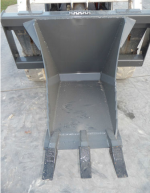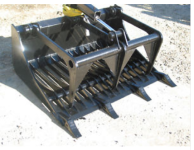sdef, do you think that bucket is capable of doing a little digging? I.e., such as digging tree roots that are within 6" - 8" of the surface? Does it seem to be built sturdy enough for that type of work?
Oh it certainly seems sturdy enough to do that but I have not tried it yet. I think the larger question would be does the tractor have enough traction/weight to do this? I was using the BB to uproot some very large parasitic vines and had the rock grapple on the tractor using it to clean up some large, dead branches as I moved around the property. I was coming up an access lane about 3 MPH or so and the tractor was rocking forward and backward a little bit as I was traveling. I hit a rougher spot, did not have the bucket high enough and it dug a couple of inches into my hard packed clay; the tractor did not slow down a bit and the bucket probably only had a bit more of its paint scratched. I attribute this to the very strong teeth and their ability to fracture the soil ahead of the cutting bar.
Some of the vines:


I am not advocating this rock bucket as a digger, as there are purpose built tools for that. I purchased a CID stump bucket for actual digging out of roots and stumps, as it is much narrower and easier to target specific areas, where the 48" rock bucket is more of a generalized tool due to its larger width. I purchased the rock bucket to scoop up rocks as I am clearing my new property's home site and felt the 48" width would do a better job than a larger bucket and would be easier to control on a micro vs. macro basis on ground that is not flat- yet. And I wanted the grapple to move downed trees and such. But with all of this said, the rock grapple bucket is now my general- stay on the tractor bucket and will use the others only when I need a more specialized tool. So this means I will probably dig with the grapple bucket in the near future

But if one is comparing a regular bucket vs. this rock bucket, there is no question in my mind that this rock buck is far sturdier than a regular bucket. It does weigh ~550 pounds and most of that weight is in the bucket construction. And most earth will be in clumps and not fall through the bottom tines so it could also do double duty as a narrow, regular bucket in many circumstances. But certainly not in sandy soil.
I purchased a toothed bar to add to the regular 72" bucket to aid in digging and scooping larger areas, but have not received it yet.
Many years ago I used to purchase tools that were generalized jack-of-all-trades. But these days I purchase quality built, single purpose type tools for their better performance at the task they are designed to do. It costs more money to do it this way as evidenced by the various buckets I now have. But in the end, my tractor and I will be much better off this way and the work will be easier to accomplish with less wear and tear on the implement and tractor alike.
Attached are the CID stump digging bucket, a general 72" rock bucket and the 48" rock grapple bucket. There are less expensive stump buckets than this one, as I have found them for as little as $495 + shipping. The grapple on the narrower 48" bucket was a bonus for me and the cost was similar to the larger bucket with no grapple. So win-win in my book. Another consideration with a rock or root bucket is the amount of steel used to build one is much greater and consequently heavier than a standard type of bucket. A 66" - 72" rock or root bucket will weigh several hundred more pounds than a 48" bucket, which detracts from the FEL overall ability to lift more weight, outside of the attached buckets, and for my uses, a larger bucket is a liability in all realms of cost and performance.







